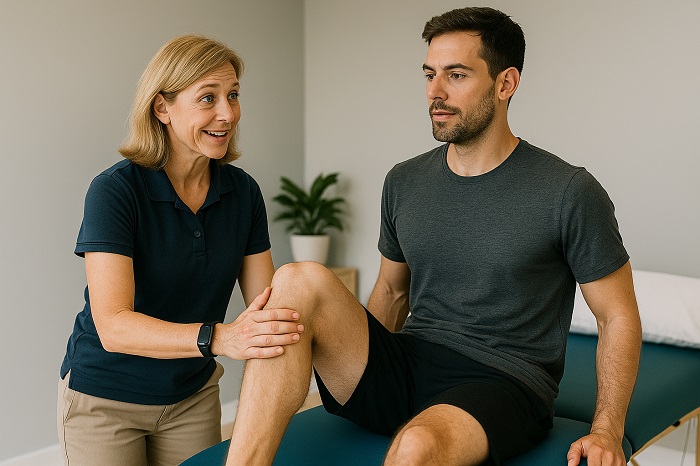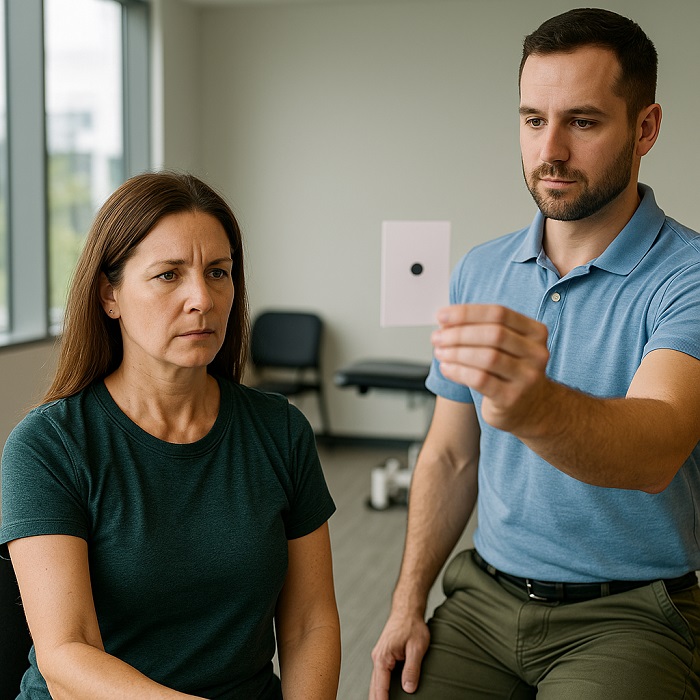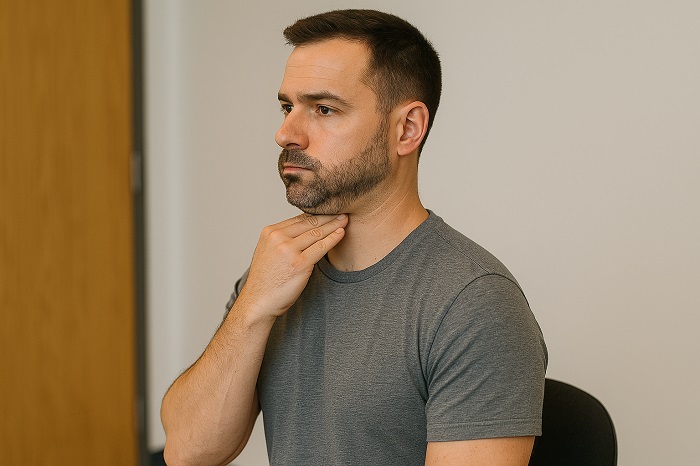Interoduction:
Concussion rehabilitation North Vancouver starts sooner than most people think. You don’t need bed rest for weeks. With the right plan, you can return to screens, work, and sport in stages within days—safely. After 24–48 hours of relative rest, we nudge activity. We keep symptoms in check. And we track gains.
Here’s the simple idea. Move a little, then measure. If symptoms rise a notch, pause, breathe, and step back. If they settle fast, you advance. Because recovery likes rhythm.
But you still need guardrails. So we set a personal heart-rate limit. Then we use short focus blocks, calm lighting, and screen breaks. We add head-eye drills and gentle neck work. Next, we test balance in quiet rooms, then in busier places. Finally, we layer in job or sport tasks.
This approach reflects current BC guidance and Parachute Canada’s best practices. It is practical. It is safe. And it fits real life in the North Shore: hills, sidewalks, SeaBus, and all. Ready to start? Let’s map your first small win today. Bring questions, bring goals, and bring comfortable walking shoes.
The North Vancouver Reality Check (Why Local Context Matters)
Concussion rehabilitation North Vancouver lives in real life—streets, screens, and schedules. Local triggers shape plans. Here’s how this plays out.
Commutes, hills, and sensory load: SeaBus, Lonsdale Quay, LED-heavy offices, and winding mountain roads—all common symptom triggers here.
Bright LEDs, engine rumbles, and crowd motion can tip symptoms. So we phase exposure. First, try short SeaBus rides at off-peak times. Stand near a window. Fix your eyes on a point. Then add Lonsdale Quay walks with pauses. For office glare, lower brightness, increase text size, and raise monitor height. North Shore hills and curvy roads? Sit front seat, shorten trips, and use gentle head turns. Track trials. If symptoms rise above 3/10 for 15 minutes, step back.
Seasonal sport patterns: Skiing/Cypress, MTB on Fromme/Griffin, trail running on Baden-Powell—how terrain and vestibular load shape rehab goals.
Winter calls for flat-ground glide before any slope. Start on a magic carpet, not moguls. For MTB, begin on gravel paths, then green trails; save head-turn drills for late. Trail runners can use softer paths and higher cadence to reduce impact. As tolerance grows, add speed or terrain, not both. Small steps win.

Insurance & admin shortcuts: What information local employers and schools typically request; how Fortius prepares it for you.
Paperwork should speed care, not stall it. We prepare a one-page summary: diagnosis, heart-rate range, screen rules, and pass criteria. Employers and schools need hours and limits. We send notes, so approvals move faster. That keeps your concussion rehabilitation on track.
24–48 Hours In—Then Movement (Not Isolation)

Concussion rehabilitation North Vancouver starts with a calm first day. Relative rest does not mean hiding in a dark room. It means smart limits. Sleep matters. Hydration matters.
What “relative rest” actually means: Sleep, hydration, light ADLs; what to avoid (heavy exertion, risk of head impact).
For the first 24 to 48 hours, aim for steady rhythms. Go to bed on time. Sip water often. Eat simple, regular meals. Keep light ADLs: short chats and an easy walk at home. However, avoid heavy exertion. Skip contact sports or rough play. Also skip risky chores like ladders or rooftop checks. Limit intense screens and long drives. If symptoms jump, pause, breathe, and try again later. Gentle is good.
Day 2 onward: graded activity beats total rest: Introduce symptom-limited walking/cycling and light cognitive load; why this improves recovery.
After that window, movement helps the brain reset. Start with a 10–15 minute walk. Or try easy cycling on a spin bike. Keep effort below your symptom ceiling. Hold a chat, read a page, or answer a few emails. Then rest. Graded activity builds tolerance without overload. It supports sleep. It speeds return to school, work, and sport. If symptoms rise more than a notch and stay, step back one level and message your clinician.
Your Multisystem Screen at Fortius (Fast, Focused, Practical)
Concussion rehabilitation North Vancouver works best when testing is quick and clear. Our visit maps the systems that drive symptoms. Then we turn findings into actions you start today.
VOR/visual screen + VOMS cluster (gaze stability, saccades, convergence) and cervical drivers (joint-position error, DNF control).
First, we check how your eyes and inner ear team up. We test gaze stability, smooth pursuit, saccades, and near-point convergence. We also run VOMS to flag motion sensitivity. Then we screen the neck. Joint-position error, mobility, and deep neck flexor control often push headaches and dizziness. Fixes here can unlock progress elsewhere.
Exertional tolerance test (to set a personal heart-rate ceiling for early cardio).
Next, we find your safe effort zone. A brief treadmill or bike test sets a personal heart-rate ceiling. Train under that ceiling without spiking symptoms. We teach how to monitor pulse and breathing so you know when to pause. Your early cardio stays confident, repeatable, and easy to track.
Balance & dual-task snapshot (quiet clinic → busy environment simulation).
Then, we sample balance in simple and complex settings. Tandem stance, head turns, and light cognitive tasks reveal limits. Finally, we simulate busy spaces to plan graded exposure for SeaBus, grocery aisles, or the office.
What you leave with today: a personal threshold HR, 2–3 vestibulo-ocular drills, 1–2 cervical drills, and a 24-hour pacing plan with clear pass criteria.
The “North Shore Ladder” (A Localized Return-to-Learn/Work/Play)
Concussion rehabilitation North Vancouver thrives on clear, local steps. Each step has pass rules, so you can self-audit between visits.
Step 1 — Screen-lite Work Blocks (Home or Office)
Start with 25–45 minute focus blocks. Take 10-minute breaks. Tweak font size, contrast, and reduce animations. Use noise control: headphones. Pass when symptoms stay ≤3/10 and settle within 15 minutes.
Step 2 — Symptom-Limited Cardio (HR ≤ personal ceiling)
Choose a flat seawall walk or an easy spin bike. Keep heart rate at or below your ceiling. Add VOR set A for 30–60 seconds, plus gentle cervical isometrics. Log symptoms now and again two hours later. Pass if both logs are steady.
Step 3 — Dual-Task & Environment Progression
Test visual motion in a grocery aisle. Try SeaBus at off-peak. Practice tandem stance with mental math. Add VOR set B. Pass when you tolerate these without a lingering spike.
Step 4 — Job-Specific Simulation
Developers and designers: a 90-minute code or design block with stand timers. Field staff: a short site walk with a buddy. Students: a half day with accommodations. Pass if the next morning feels baseline.

Step 5 — Sport-Specific Non-Contact
Run track repeats or grass drills. MTB stays on gravel. Skiers: flat shuffle drills. Add agility without contact. Pass after two stable sessions.
Step 6 — Full Workload / Contact-Ready
Remove accommodations. Coach, AT, or HR gets the final clearance note. Contact returns only after clinician sign-off, aligned with Canadian/BC guidance and Parachute, safely.
Stakeholder Huddles That Prevent Setbacks
Concussion rehabilitation North Vancouver runs smoother with quick huddles. Ten minutes can save a week. Here’s how we set the guardrails and keep everyone rowing in the same direction.
The 10-minute “Decision Conference”: patient + clinician + employer/coach agree on this week’s limits, HR ceiling, and pass criteria.
We gather the key people. Then we set this week’s limits, training zones, and pass rules. Short and sweet.
-
Work/School load: hours, screen rules, and shift changes.
-
HR ceiling: your safe number for walks, bike, or gym.
-
Drills: VOR sets, cervical work, and balance tasks.
-
Pass/Hold: what lets you move up; what sends you back one step.
We book a check-in. We also pick a contact person, so messages don’t scatter. Finally, we confirm how to log results.
Red Flags vs. Normal Fluctuations
Concussion rehabilitation North Vancouver should feel structured and safe. Some days dip. Others rise. Know what needs help now, and what needs a pause.
Call 9-1-1 / urgent care: neurological deficits, repeated vomiting, severe/worsening headache, seizure, neck instability.
Do not wait. Seek help fast. Call 9-1-1 or go to urgent care if you notice:
-
Weakness, numbness, slurred speech, or facial droop.
-
Vomiting more than once.
-
A severe or worsening headache unlike your usual.
-
A seizure.
-
New neck pain with stiffness or instability.
If unsure, seek care.
Typical rehab “blips”: 1–3 point symptom bump that settles within ~15–30 minutes after stopping a task—what to do when it happens (back one step, retry in 24h).
Small spikes happen. You do a task. Symptoms rise by one to three points. You stop. Within 15–30 minutes, they settle. That is a “blip.” Here’s the play:
-
Mark the task and time.
-
Step back one level for the next session.
-
Keep hydration, sleep, and meals steady.
-
Retry in 24 hours at the easier level.
If symptoms linger past 30 minutes, hold the task and message your clinician. This graded approach aligns with BC guidance. It protects progress. And it keeps you moving forward, one safe step at a time.
The Screen-Smart Toolkit (For North Vancouver’s Knowledge Workers)

Concussion rehabilitation North Vancouver must fit desk life at work daily. Screens can help or hurt. Use these wins.
Four levers: time, size, brightness, distance—how to adjust each.
Time: work in short blocks. Start with 25–30 minutes, then rest. Size: increase text and cursor. Use high contrast; avoid harsh whites. Brightness: match room light; avoid glare; enable night shift after sunset. Distance: keep the monitor an arm’s length; raise the top edge to eye level. Test one change at a time. Keep what calms symptoms.
A/B your setup: laptop + external keyboard vs. external monitor; which configuration typically settles symptoms faster and why.
Try two setups. First, laptop on a stand with external keyboard and mouse. Second, a single external monitor, laptop closed. Many prefer monitor-only. It gives a steady focal point, better height, fewer moving elements. Keep frame rate smooth and reduce animations. Choose the option that keeps symptoms ≤3/10 for a block.
The 20-5-20 rule: every 20 minutes, 5-minute off-screen + 20-foot focus shift.
Set a timer. Work 20 minutes. Then look 20 feet away. Walk, breathe, sip water for five minutes. Return to the task. This simple loop lowers visual load, helps posture, and supports recovery. Repeat daily. Note how you feel two hours later.
Cervical Meets Vestibular (Headache Isn’t Always Migraine)
Concussion rehabilitation North Vancouver often starts with your neck. Many “migraine-like” headaches are cervical. The neck and the inner ear talk. When the neck is tense or weak, dizziness can hang around. So we check both systems. Then we treat both.
Cervicogenic headache hallmarks and why deep neck flexor endurance changes symptoms.
Cervicogenic pain is often one-sided. It can start in the upper neck and spread to the eye or temple. It rises with poor posture, long screens, or long drives. Pressing tender spots near C2–C3 may copy the pain. Turning the head can spark it. However, deep neck flexors calm the storm. These muscles steady joints. With better endurance, joints stop shouting. Then headaches fade. Quick test: chin nods feel hard at first; with practice, they feel smooth.
The “neck first” days: why 2–3 days of cervical-dominant work can kick-start VOR progress in some patients.
For a few days, we go neck heavy. We use mobility, chin nods, and low-load holds. We pair that with breathing and walks. As tone drops, eye–head work lands better. VOR drills flare less. Balance feels steadier. Next, we reintroduce gaze tasks in small sets. If symptoms stay ≤3/10 and settle fast, we advance. If not, we hold and review form. Simple. Clear. Doable.

From Seawall to Singletrack (Sport-Specific Progressions You Won’t Find in Generic Guides)
Concussion rehabilitation North Vancouver should fit your sport and your trails. We keep it steady, local, and safe. Each step has pass rules. No contact until cleared.
Runners: cadence-up, impact-down progression; track → soft trail → rolling terrain.
Start on a track. Short intervals. Higher cadence, smaller steps. Arms relaxed. If symptoms stay ≤3/10 and settle within 15 minutes, add distance. Next, move to a soft trail. Keep pace easy. Later, test rolling paths like the Spirit Trail. Finally, add mild hills. However, increase only one variable at a time: speed, distance, or terrain.
Cyclists/MTB: stationary → road → gravel path → green trail only; add head-turn intervals late.
Begin on a stationary bike under your heart-rate ceiling. Then try short road spins on flat ground. After that, ride a gravel path. Smooth turns. Eyes level. Green trail comes last. Save head-turn intervals for late stages. Log symptoms right after and two hours later. Pass when both are stable.
Skiers/Snowboarders: flat balance + vestibular drills → magic carpet glide → green slope edge drills; no terrain park until full clearance.
First, practice flat balance with gentle gaze drills. Then try a magic carpet glide. Short runs. Calm stops. When steady, add green slope edge drills. Link easy turns. Skip the terrain park until you receive full clearance under BC and Parachute guidance. Progress with patience. It pays off.
When WorkSafeBC Applies (and How We Help)
Concussion rehabilitation North Vancouver often intersects with work claims. If your injury happened on the job, WorkSafeBC may apply. We keep the steps simple and clear.
If your concussion is work-related: early assessment + education, individualized plan aimed at a durable return to work (ECAT/PCMP).
Book an early assessment. We explain symptoms, pacing, and red flags in plain language. Then we build an individualized plan aimed at a durable return. When needed, we align care with WorkSafeBC pathways, including ECAT and PCMP. You get a personal heart-rate ceiling, screen rules, and staged duties. We coach supervisors on safe expectations. Everyone knows weekly pass criteria before you leave.
What we include in reports: job demands, exposure plan, re-integration timeline, monitoring cadence.
Our reports remove guesswork. We summarize your job’s physical and cognitive demands. We list allowable exposures: screen time per block, noise, lifting, driving, travel. We provide a re-integration timeline with milestones, week by week. We set a monitoring cadence: check-ins, symptom logs, and who reads them. We attach advance/hold rules and the 24-hour recovery rule. HR and case managers can apply the plan without decoding jargon. If your condition changes, we update the report and notify stakeholders. Result: fewer delays, fewer setbacks, and a steadier path back to safe work.
Your 10-Minute Daily Ritual (Micro-Wins That Compound)
Concussion rehabilitation North Vancouver improves with tiny, repeatable wins. This ritual takes ten minutes. Do it once or twice. Keep it simple. Keep it honest.
Three blocks: (1) sub-symptom cardio, (2) VOR/visual set, (3) cervical set.
Block one: two to three minutes of easy walking or spin. Stay under your personal heart-rate ceiling. You should speak in full sentences. Stop if symptoms jump.
Block two: VOR or visual work for 60–90 seconds. Pick one target at eye level. Turn your head gently while eyes stay locked. Rest 30–60 seconds. Then repeat once.
Block three: the neck. Ten slow chin nods. Then a 20–30 second deep neck flexor hold. Breathe low. Shoulders relaxed. Finish with two gentle range-of-motion arcs—left to right, up to down. That’s it.
The “+2-hour check-in”: why delayed symptom tracking predicts tomorrow’s plan better than in-the-moment scores.
Right after the ritual, jot a quick score. Then, two hours later, check again. Some brains flare late. If your +2-hour score rises by two or more, step back tomorrow. Shorter sets. Slower turns. If it stays level, add a tiny bit. Ten percent more time works well. Keep water nearby. Sleep on schedule. And remember: consistency beats hero days. Small steps, stacked daily, move you farther than one giant leap.
FAQ (AEO-Ready, Short Answers On-Page + FAQPage Schema)
How long does recovery usually take?
Most people improve over 2–6 weeks. Complex cases take longer. We pace activity and adjust weekly under BC guidance.
Is screen time allowed?
Yes, in short blocks. Use larger text, lower brightness, and regular breaks. Stop if symptoms rise and don’t settle within 15–30 minutes.
When can I exercise again?
After 24–48 hours, start light cardio under your personal HR ceiling. Add vestibulo-ocular and neck work as tolerated.
Do I need imaging?
Usually no. Imaging is for red flags or suspected structural injury. Ask if severe headache, repeated vomiting, or neuro changes appear.
Who needs medical referral?
Anyone with red flags, slow progress, or medication questions. We coordinate with your GP under Government of British Columbia guidance.
Why Fortius Center (What You’ll Notice Here)
Concussion rehabilitation North Vancouver done our way is practical. We set a personal HR ceiling on Day 1, not “rest until symptoms vanish.” We map local terrain progressions for runners, cyclists/MTB, and snow sports. And we provide employer/coach-ready documents that reduce back-and-forth and speed safe clearance. Ready to move? We keep messaging simple, timelines clear, and next steps visible in your plan.
Book Concussion Assessment • Call 604-210-6050 • Directions to W 17th off Lonsdale.
Implementation notes (for your CMS)
-
Put the focus keyword in the first 100 words and at least one H2.
-
Add FAQPage JSON-LD. Align pass criteria with BC guidance.
-
Internally link to the Concussion, Vestibular, and Contact/Booking pages on fortiuscenter.com.
-
Use short paragraphs, varied sentence lengths, and active voice for engagement.

